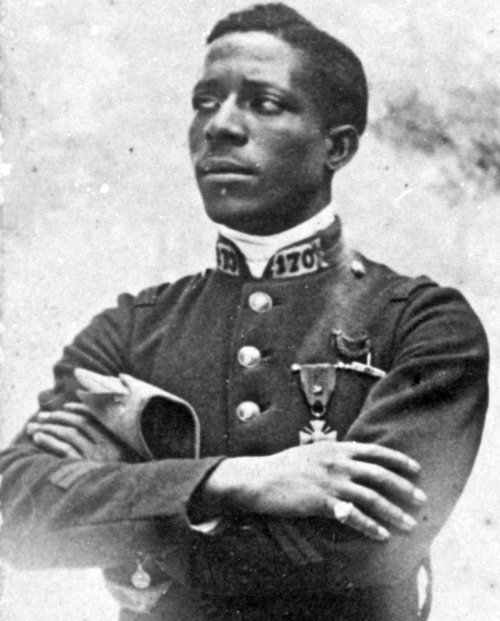First Black Fighter Pilot Soared to New Heights
| Table of Contents | |
| Who is Eugene Bullard? | |
| His Journey to Become a Pilot | |
| A Celebrated and Unsung Hero | |
| Posthumous Recognition |
Eugene Jacques Bullard is America’s first Black pilot to fly in combat and the only African American pilot in World War I.
Although born in the United States, Eugene didn’t serve in the U.S. military. He enlisted in the French Foreign Legion when WWI began in 1914.
He was a highly decorated service member in France and lived an incredible life of service during both WWI and WWII. His accomplishments, however, went largely unnoticed in America until after his death. His story is one of humility and honor.
Who is Eugene Bullard?
Eugene Jacques Bullard is a war hero who flew planes decades before the Tuskegee Airmen. He was honored by French President Charles de Gaulle and friends with famous people like Louis Armstrong.
Born in 1895 in Columbus, Georgia, Eugene’s grandfather was a slave. Multiple biographers agree that Eugene left home on his own as a child after witnessing his father’s near-lynching. He stowed away on a ship to the U.K. and ended up in London, earning a living as a boxer and entertainer. By 1913, he had 42 professional fights under his belt and was living in Paris.
Fast forward a year, and WWI had begun.
Eugene joined the French Foreign Legion in 1914 as other American expats did at the time. He fought in the trench war at Champagne and Verdun, was wounded three times, and kept returning to fight.
By March 1916, he was seriously injured and removed from the battlefield. He lost most of his teeth and had a hole in his thigh from an artillery shell. Doctors told him he might never walk again.
| EUGENE BULLARD, USAF |
|
|
Career Highlights
|
His Journey to Become a Pilot
Eugene earned France’s highest honors for his service and sacrifice, including a Croix de Guerre and a Medaille Militaire. When he was deemed too injured for infantry combat because of his leg wound and issued a medical discharge, he insisted on a transfer to the French Air Force. He succeeded. Eugene received his pilot license in 1917.
Eugene flew more than 20 combat missions, even with the odds stacked against him. Despite previous injuries and racial bias, he became a decorated soldier and French pilot. He was known as the Black Sparrow of Death.
When the U.S. entered the war, Eugene attempted to fly for the U.S. Air Service, but at the time, the U.S. had banned Black pilots from joining. Bullard rejoined the Aéronautique Militaire but was dismissed following an apparent conflict with a French officer. Subsequently, he went back to serving in the 170th Infantry Regiment until his release in October 1919.
A Celebrated and Unsung Hero
After serving in WWI, Eugene stayed in Europe and ran successful nightclubs in Paris that attracted American writers, including Ernest Hemingway, F. Scott Fitzgerald, and Langston Hughes. He mentored jazz musicians Sidney Bechet and Ada “Bricktop” Smith, among others. He operated a gym, as well.
Because Eugene spoke English, French, and German he was re-recruited to help the French Resistance as a spy during WWII. He overheard valuable information at his nightclub. But when the Germans invaded France in 1940, his friends were able to whisk him back to the U.S.

At that point, it had been over three decades since Eugene had been home to the United States. He settled in New York, working at the Staten Island shipyards.
In 1954, French President Charles de Gaulle invited Eugene to light the torch at the Tomb of the Unknown Soldier at the Arc de Triomphe. At the time, he worked as an elevator operator at Rockefeller Center.
In 1959, France named him Chevalier de la Legion D’Honneur for his service in both WWI and WWII.
When French President Charles de Gaulle visited the U.S., he inquired about French hero Eugene Bullard. The FBI had to locate him for a quick meeting with de Gaulle. After the meeting, Eugene caught the attention of national media and appeared on The Today Show on NBC, in the same building where he operated the elevator.
Posthumous Recognition
Sadly, Eugene died from cancer in 1961. He is buried in Flushing, New York, in the Federation of French War Veterans Cemetery.
After his death, Eugene was named second lieutenant in the U.S. Air Force in 1994. In 2019, the Air Force dedicated a statue of Eugene Bullard at the Museum of Aviation at Robins Air Force Base in Georgia, his home state. Several of his descendants were in attendance.
Eugene Bullard took himself to new heights in the face of racial violence, poverty, and combat injuries. He fought for freedom wherever he went — and wrote his destiny as an American hero across borders.
Learn more about pioneering pilot Eugene Bullard in this 11-minute film festival favorite or watch this PBS American Experience documentary.
SOURCES:
- Clavin, Tom and Keith, Phil, All Blood Runs Red: The Legendary Life of Eugene Bullard – Boxer, Pilot, Soldier, Spy. (New York: Hanover Square Press, 2019).
- Harris, Henry S., All Blood Runs Red: Life and Legends of Eugene Jacques Bullard – First Black American Military Aviator. (Melbourne: eBookIt, 2013)
- Salter, Krewasky A., Combat Multipliers: African American Soldiers in Four Wars. (Kansas: Combat Studies Institute Press, Fort Leavenworth, 2003).
- https://www.nationalmuseum.af.mil/Visit/Museum-Exhibits/Fact-Sheets/Display/Article/197458/eugene-jacques-bullard/
- Photo courtesy of DVIDS.
